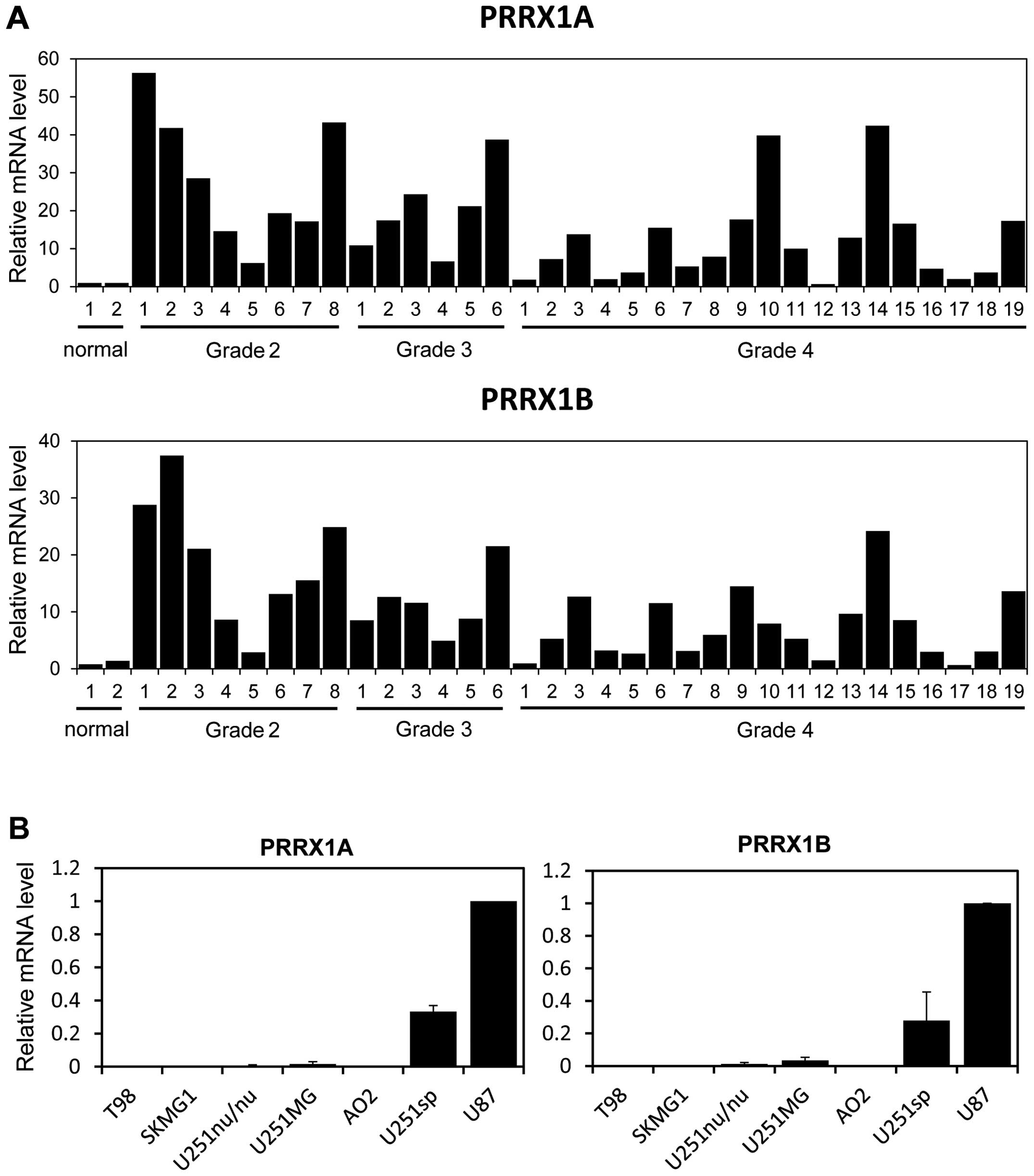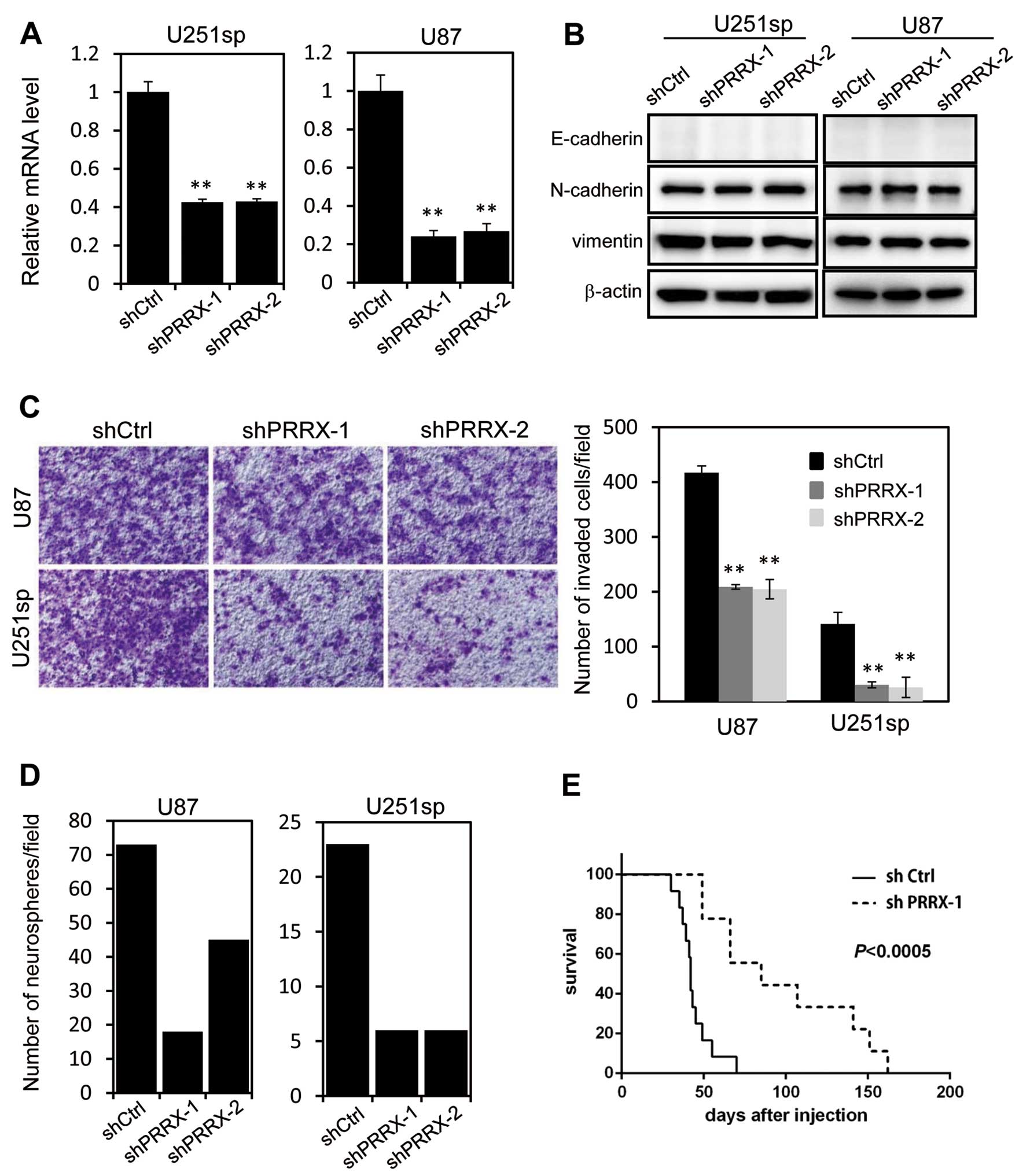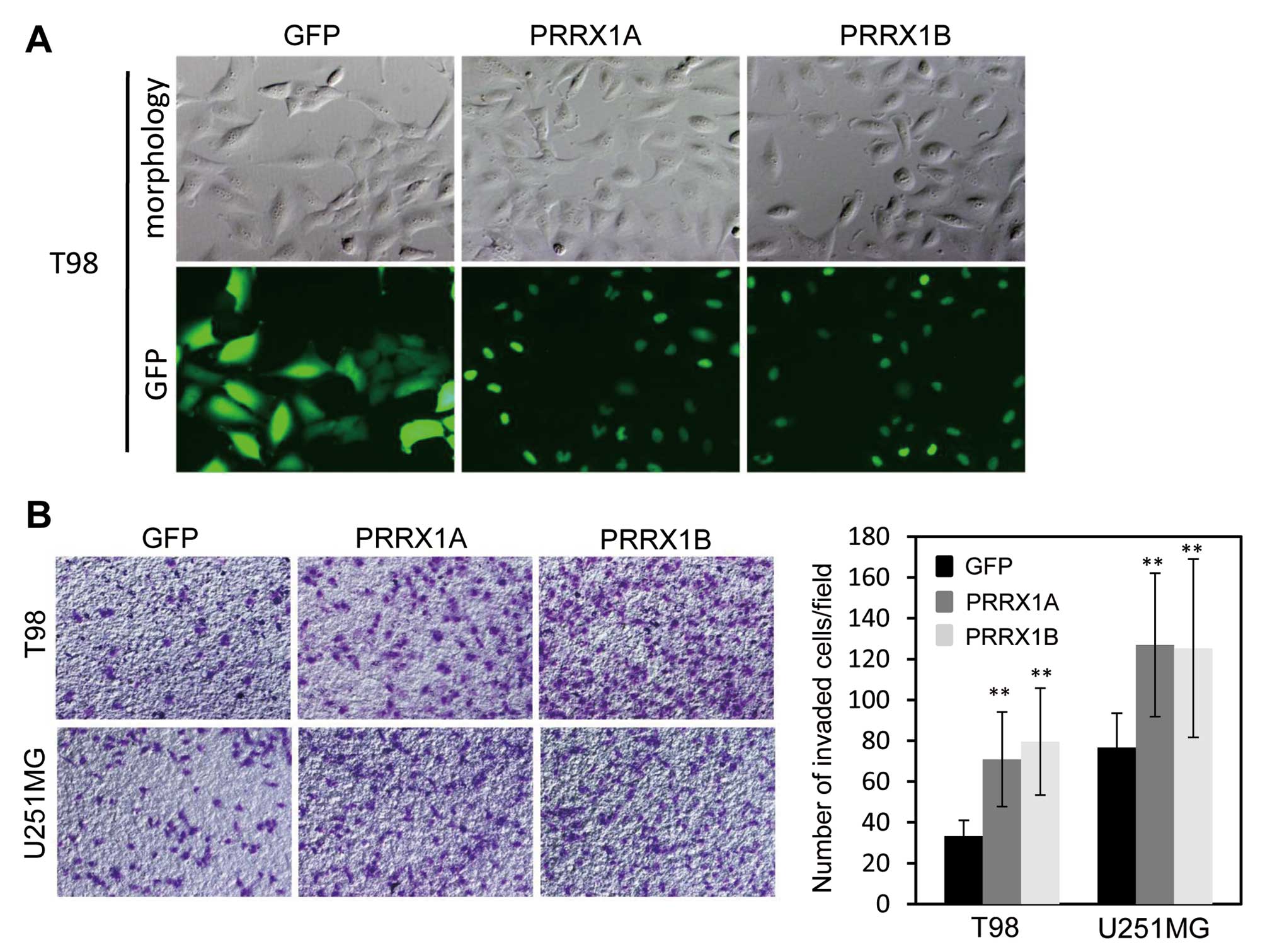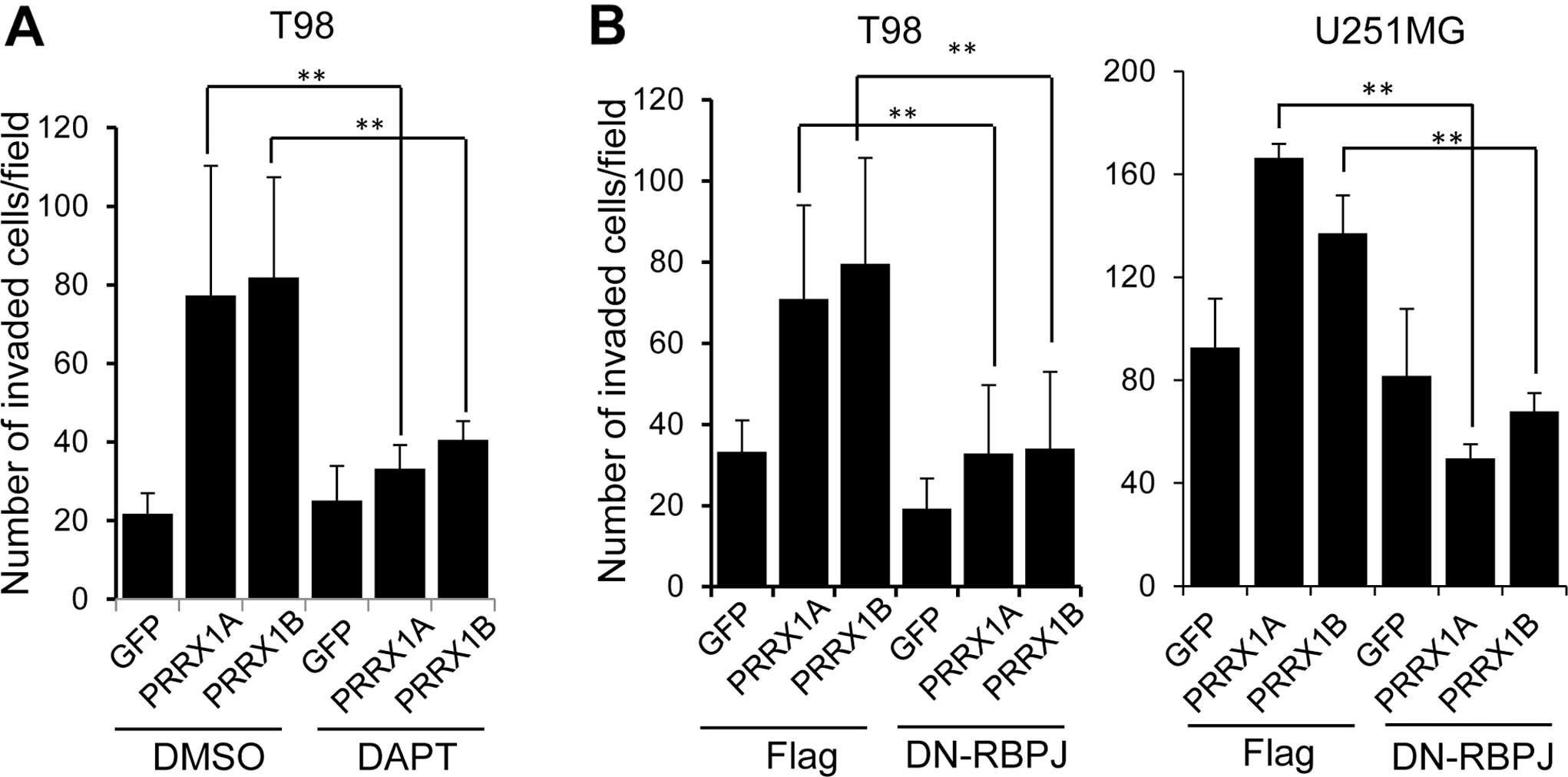|
1
|
Wen PY and Kesari S: Malignant gliomas in
adults. N Engl J Med. 359:492–507. 2008. View Article : Google Scholar : PubMed/NCBI
|
|
2
|
Bello L, Giussani C, Carrabba G, Pluderi
M, Costa F and Bikfalvi A: Angiogenesis and invasion in gliomas.
Cancer Treat Res. 117:263–284. 2004. View Article : Google Scholar : PubMed/NCBI
|
|
3
|
Shah N and Sukumar S: The Hox genes and
their roles in onco-genesis. Nat Rev Cancer. 10:361–371. 2010.
View Article : Google Scholar : PubMed/NCBI
|
|
4
|
Coletta RD, Christensen KL, Micalizzi DS,
Jedlicka P, Varella-Garcia M and Ford HL: Six1 overexpression in
mammary cells induces genomic instability and is sufficient for
malignant transformation. Cancer Res. 68:2204–2213. 2008.
View Article : Google Scholar : PubMed/NCBI
|
|
5
|
McCoy EL, Iwanaga R, Jedlicka P, et al:
Six1 expands the mouse mammary epithelial stem/progenitor cell pool
and induces mammary tumors that undergo epithelial-mesenchymal
transition. J Clin Invest. 119:2663–2677. 2009. View Article : Google Scholar : PubMed/NCBI
|
|
6
|
Yuan H, Kajiyama H, Ito S, et al: ALX1
induces snail expression to promote epithelial-to-mesenchymal
transition and invasion of ovarian cancer cells. Cancer Res.
73:1581–1590. 2013. View Article : Google Scholar : PubMed/NCBI
|
|
7
|
Costa BM, Smith JS, Chen Y, et al:
Reversing HOXA9 oncogene activation by PI3K inhibition: epigenetic
mechanism and prognostic significance in human glioblastoma. Cancer
Res. 70:453–462. 2010. View Article : Google Scholar : PubMed/NCBI
|
|
8
|
Kern MJ, Argao EA, Birkenmeier EH, Rowe LB
and Potter SS: Genomic organization and chromosome localization of
the murine homeobox gene Pmx. Genomics. 19:334–340. 1994.
View Article : Google Scholar : PubMed/NCBI
|
|
9
|
Norris RA, Scott KK, Moore CS, et al:
Human PRRX1 and PRRX2 genes: cloning, expression, genomic
localization, and exclusion as disease genes for Nager syndrome.
Mamm Genome. 11:1000–1005. 2000. View Article : Google Scholar : PubMed/NCBI
|
|
10
|
Martin JF, Bradley A and Olson EN: The
paired-like homeo box gene MHox is required for early events of
skeletogenesis in multiple lineages. Genes Dev. 9:1237–1249. 1995.
View Article : Google Scholar : PubMed/NCBI
|
|
11
|
Takahashi Y, Sawada G, Kurashige J, et al:
Paired related homoeobox 1, a new EMT inducer, is involved in
metastasis and poor prognosis in colorectal cancer. Br J Cancer.
109:307–311. 2013. View Article : Google Scholar : PubMed/NCBI
|
|
12
|
Ocaña OH, Córcoles R, Fabra A, et al:
Metastatic colonization requires the repression of the
epithelial-mesenchymal transition inducer Prrx1. Cancer Cell.
22:709–724. 2012. View Article : Google Scholar : PubMed/NCBI
|
|
13
|
Shimozaki K, Clemenson GD Jr and Gage FH:
Paired related homeobox protein 1 is a regulator of stemness in
adult neural stem/progenitor cells. J Neurosci. 33:4066–4075. 2013.
View Article : Google Scholar : PubMed/NCBI
|
|
14
|
Bass AJ, Watanabe H, Mermel CH, et al:
SOX2 is an amplified lineage-survival oncogene in lung and
esophageal squamous cell carcinomas. Nat Genet. 41:1238–1242. 2009.
View Article : Google Scholar : PubMed/NCBI
|
|
15
|
Gangemi RM, Griffero F, Marubbi D, et al:
SOX2 silencing in glioblastoma tumor-initiating cells causes stop
of proliferation and loss of tumorigenicity. Stem Cells. 27:40–48.
2009. View Article : Google Scholar
|
|
16
|
Fang X, Yu W, Li L, et al: ChIP-seq and
functional analysis of the SOX2 gene in colorectal cancers. OMICS.
14:369–384. 2010. View Article : Google Scholar : PubMed/NCBI
|
|
17
|
Alonso MM, Diez-Valle R, Manterola L, et
al: Genetic and epigenetic modifications of Sox2 contribute to the
invasive phenotype of malignant gliomas. PLoS One. 6:e267402011.
View Article : Google Scholar : PubMed/NCBI
|
|
18
|
Ohta S, Mizuno M, Takaoka T and Yoshida J:
Augmentation of anti-Fas antibody-mediated apoptosis on human
glioma cells by liposomes associated with the antibody. J
Neurooncol. 35:7–11. 1997. View Article : Google Scholar : PubMed/NCBI
|
|
19
|
Kurooka H, Kuroda K and Honjo T: Roles of
the ankyrin repeats and C-terminal region of the mouse Notch1
intracellular region. Nucleic Acids Res. 26:5448–5455. 1998.
View Article : Google Scholar : PubMed/NCBI
|
|
20
|
Sasaki H, Hui C, Nakafuku M and Kondoh H:
A binding site for Gli proteins is essential for HNF-3β floor plate
enhancer activity in transgenics and can respond to Shh in vitro.
Development. 124:1313–1322. 1997.PubMed/NCBI
|
|
21
|
Kaykas A, Yang-Snyder J, Héroux M, Shah
KV, Bouvier M and Moon RT: Mutant Frizzled 4 associated with
vitreoretinopathy traps wild-type Frizzled in the endoplasmic
reticulum by oligo-merization. Nat Cell Biol. 6:52–58. 2004.
View Article : Google Scholar
|
|
22
|
Lino MM, Merlo A and Boulay JL: Notch
signaling in glioblastoma: a developmental drug target? BMC Med.
8:722010. View Article : Google Scholar : PubMed/NCBI
|
|
23
|
Mimeault M and Batra SK: Complex oncogenic
signaling networks regulate brain tumor-initiating cells and their
progenies: pivotal roles of wild-type EGFR, EGFRvIII mutant and
hedgehog cascades and novel multitargeted therapies. Brain Pathol.
21:479–500. 2011.PubMed/NCBI
|
|
24
|
Paul I, Bhattacharya S, Chatterjee A and
Ghosh MK: Current understanding on EGFR and Wnt/β-catenin signaling
in glioma and their possible crosstalk. Genes Cancer. 4:427–446.
2013. View Article : Google Scholar
|
|
25
|
Tanigaki K and Honjo T: Two opposing roles
of RBP-J in Notch signaling. Curr Top Dev Biol. 92:231–252. 2010.
View Article : Google Scholar : PubMed/NCBI
|
|
26
|
Thiery JP, Acloque H, Huang RY and Nieto
MA: Epithelial-mesenchymal transitions in development and disease.
Cell. 139:871–890. 2009. View Article : Google Scholar : PubMed/NCBI
|
|
27
|
Leussink B, Brouwer A, el Khattabi M,
Poelmann RE, Gittenberger-de Groot AC and Meijlink F: Expression
patterns of the paired-related homeobox genes MHox/Prx1 and S8/Prx2
suggest roles in development of the heart and the forebrain. Mech
Dev. 52:51–64. 1995. View Article : Google Scholar : PubMed/NCBI
|
|
28
|
Norris RA and Kern MJ: The identification
of Prx1 transcription regulatory domains provides a mechanism for
unequal compensation by the Prx1 and Prx2 loci. J Biol Chem.
276:26829–26837. 2001. View Article : Google Scholar : PubMed/NCBI
|
|
29
|
Brouwer A, ten Berge D, Wiegerinck R and
Meijlink F: The OAR/aristaless domain of the homeodomain protein
Cart1 has an attenuating role in vivo. Mech Dev. 120:241–252. 2003.
View Article : Google Scholar : PubMed/NCBI
|
|
30
|
Reichert M, Takano S, von Burstin J, et
al: The Prrx1 homeodomain transcription factor plays a central role
in pancreatic regeneration and carcinogenesis. Genes Dev.
27:288–300. 2013. View Article : Google Scholar : PubMed/NCBI
|
|
31
|
Chen X, Thiaville MM, Chen L, et al:
Defining NOTCH3 target genes in ovarian cancer. Cancer Res.
72:2294–2303. 2012. View Article : Google Scholar : PubMed/NCBI
|
|
32
|
Saito N, Fu J, Zheng S, et al: A high
Notch pathway activation predicts response to γ secretase
inhibitors in proneural subtype of glioma tumor-initiating cells.
Stem Cells. 32:301–312. 2014. View Article : Google Scholar :
|














